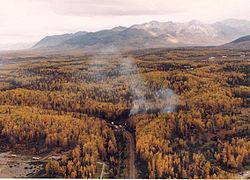Aircraft type Boeing E-3B Sentry Date 22 September 1995 Total fatalities 24 (all) | Registration 77-0354 Crew count 24 | |
 | ||
Site Near Elmendorf Air Force Base, Alaska, United States Similar Knight Air Flight 816, Cameroon Airlines Flight 3701, Nigeria Airways Flight 357, Azerbaijan Airlines Flight 56, 1995 Borodianka mid‑air co | ||
The Alaska Boeing E-3 Sentry accident was the crash on 22 September 1995 of a United States Air Force Boeing E-3 Sentry airborne early warning aircraft with the loss of all 24 on board. The aircraft, serial number 77-0354 with callsign Yukla 27 hit birds on departure from Elmendorf Air Force Base in Alaska, United States, with the loss of power from two engines the aircraft crashed into a wooded area less than a mile from the end of the runway.
Contents
Accident
The Sentry was being operated by the 962nd Airborne Air Control Squadron and was preparing to go on a training sortie with the callsign Yukla 27. The aircraft was to depart from runway 06 and was waiting while a Hercules transport aircraft took off. With its crew unaware that the Hercules had disturbed a flock of Canada geese, the Sentry lined up and started its departure roll, as it rotated No. 1 and No. 2 engines ingested the birds. The crew started to turn to the left to dump fuel and return to the runway, after the aircraft reached 250 feet it descended and crashed into a hilly, wooded area and exploded.
Investigation
The investigation concluded that the probable cause was the ingestion of Canada geese into No. 1 and No. 2 engines. Other factors were the insufficient efforts of the air base to deter the birds and the failure of the air traffic tower to report to both the Sentry and the airfield management that birds were present on the airfield.
The sequence of events during impact was also determined. The aircraft struck the ground nose first. As the aircraft slid to the top of the second hill, the empennage (tail section) broke off. "As the [aircraft] cleared the second hill, it rolled over. The fuselage broke up as the [aircraft] rolled. The outboard right wing impacted on the left side of the wreckage, the right-hand wing broke off and the rotodome section impacted on its back, breaking up the rest of the aircraft."
Investigators reviewed the flight and wreckage path of the accident aircraft. "The [aircraft] lifted off and flew approximately [1.28 kilometers (0.8 mile)] before contacting trees," the report said. "The [aircraft] then flew approximately [0.72 kilometer (0.45 mile)] before making contact with the ground and crashing in a fireball."
Aircraft
The Boeing E-3 Sentry serial number 77-0354 was built as an E-3A variant with the Boeing construction number 21554 and line number 933, it first flew on 5 July 1978 and was delivered to the United States Air Force on 19 January 1979. It was later modified by Boeing to E-3B standard.
This aircraft was used on the first day of Desert Storm air war, with its crew controlling the intercept and shootdown of four Iraqi fighter aircraft.
The aircraft was also involved in the 14 April 1994 Black Hawk shootdown incident in Iraq, where the crew witnessed two F-15 fighter aircraft shoot down two non-maneuvering US Army helicopters killing 26 military and civilian personnel.
